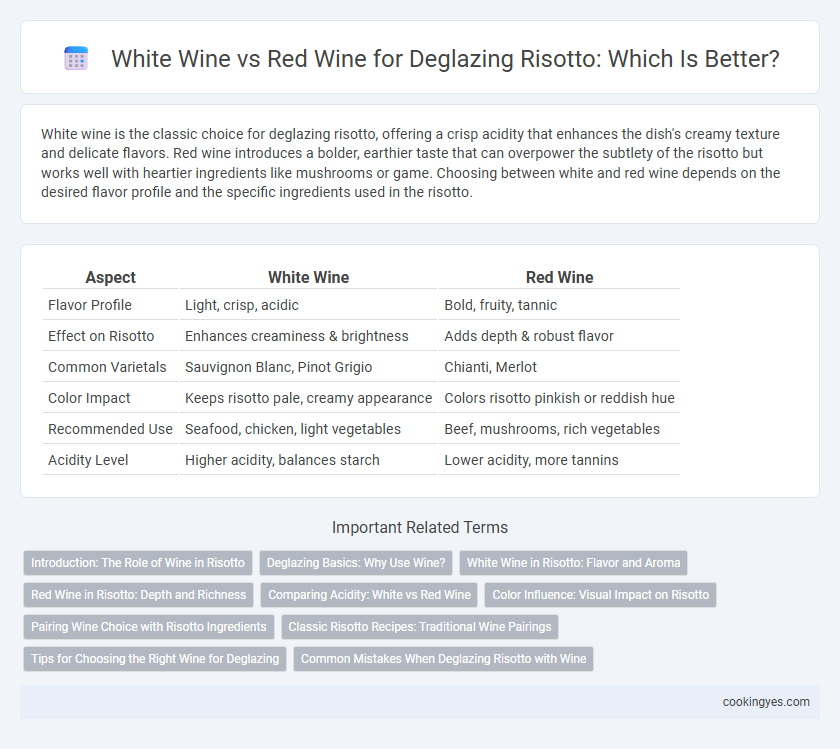White wine is the classic choice for deglazing risotto, offering a crisp acidity that enhances the dish's creamy texture and delicate flavors. Red wine introduces a bolder, earthier taste that can overpower the subtlety of the risotto but works well with heartier ingredients like mushrooms or game. Choosing between white and red wine depends on the desired flavor profile and the specific ingredients used in the risotto.
Table of Comparison
| Aspect | White Wine | Red Wine |
|---|---|---|
| Flavor Profile | Light, crisp, acidic | Bold, fruity, tannic |
| Effect on Risotto | Enhances creaminess & brightness | Adds depth & robust flavor |
| Common Varietals | Sauvignon Blanc, Pinot Grigio | Chianti, Merlot |
| Color Impact | Keeps risotto pale, creamy appearance | Colors risotto pinkish or reddish hue |
| Recommended Use | Seafood, chicken, light vegetables | Beef, mushrooms, rich vegetables |
| Acidity Level | Higher acidity, balances starch | Lower acidity, more tannins |
Introduction: The Role of Wine in Risotto
Wine plays a crucial role in developing the complex flavors of risotto by deglazing the pan and enhancing the dish's aroma. White wine is traditionally preferred for its acidity and light, crisp notes that complement the creamy texture without overpowering the rice. Red wine can introduce deeper, bolder flavors but may alter the color and subtle balance of classic risotto varieties.
Deglazing Basics: Why Use Wine?
Deglazing risotto with white wine enhances the dish by adding bright acidity and subtle fruity notes that balance the creamy texture of Arborio rice. White wine's higher acidity and lighter flavor profile prevent overpowering the delicate ingredients, allowing the natural flavors of mushrooms, seafood, or vegetables to shine through. Red wine, with its robust tannins and deeper color, can overpower the dish and alter risotto's traditional creamy appearance and flavor balance.
White Wine in Risotto: Flavor and Aroma
White wine enhances risotto by imparting a bright, acidic flavor that balances the creamy texture and rich ingredients. Its fruity and floral aroma blends seamlessly with the rice, elevating the dish's overall sensory appeal. Common varieties like Pinot Grigio or Sauvignon Blanc are preferred for their crispness and subtle complexity.
Red Wine in Risotto: Depth and Richness
Red wine adds depth and richness to risotto by infusing the dish with robust tannins and complex fruit flavors such as blackberry, cherry, and plum, creating a more intense and savory profile. Its acidity balances the creaminess of Arborio rice, enhancing the overall mouthfeel and elevating the umami notes of Parmesan cheese or mushrooms often used in risotto recipes. Although less traditional than white wine, red wine varieties like Pinot Noir or Barbera can transform risotto into a bold and hearty dish with a distinctive color and aromatic sophistication.
Comparing Acidity: White vs Red Wine
White wine, commonly used in risotto, offers higher acidity with bright, crisp notes that enhance the dish's creamy texture without overpowering subtle flavors. Red wine has lower acidity and a bolder, fruitier profile that can dominate the delicate balance of risotto, often altering its intended lightness. Choosing white wine for deglazing ensures optimal acidity, preserving risotto's signature creaminess and flavor harmony.
Color Influence: Visual Impact on Risotto
White wine deglazes risotto without altering its creamy, pale appearance, preserving the dish's classic, visually appealing color. Red wine imparts a reddish or purplish hue, dramatically changing the risotto's visual profile and potentially overshadowing its traditional look. The choice between white and red wine directly influences the risotto's color, affecting its overall presentation and perceived flavor intensity.
Pairing Wine Choice with Risotto Ingredients
White wine is preferred for deglazing risotto due to its crisp acidity and light profile, which complement delicate ingredients like seafood, asparagus, or mushrooms without overpowering their flavors. Red wine, with its robust tannins and deeper color, suits richer risottos featuring red meats, tomatoes, or strong cheeses, enhancing the dish's earthiness and depth. Selecting the appropriate wine based on risotto ingredients optimizes flavor balance and elevates the overall dining experience.
Classic Risotto Recipes: Traditional Wine Pairings
Classic risotto recipes traditionally favor white wine for deglazing due to its light acidity and subtle fruitiness, which complement the creamy texture and delicate flavors of Arborio rice and Parmesan cheese. White wines such as Pinot Grigio or Sauvignon Blanc enhance the savory notes without overpowering the dish, maintaining the risotto's creamy consistency. Red wine, with its bolder tannins and deeper flavors, can overwhelm the classic risotto profile but may be suited to heartier variations featuring robust ingredients like mushrooms or beef.
Tips for Choosing the Right Wine for Deglazing
Selecting white wine for deglazing risotto enhances the dish with crisp acidity and subtle fruit notes that complement the creamy texture. Opt for dry white wines like Sauvignon Blanc or Pinot Grigio to avoid overpowering flavors and maintain the risotto's delicate balance. Avoid heavy or tannic red wines, as their strong flavors can clash with the rice and diminish the dish's harmonious taste.
Common Mistakes When Deglazing Risotto with Wine
Using red wine to deglaze risotto can overpower the dish with tannins, resulting in a bitter and muddy flavor profile. Common mistakes include adding wine at too high a temperature, causing premature alcohol evaporation and loss of delicate aromas. For optimal balance, white wine with crisp acidity and subtle fruit notes is preferred to enhance the risotto's creamy texture without overwhelming its flavor.
White wine vs red wine for deglazing risotto Infographic

 cookingyes.com
cookingyes.com